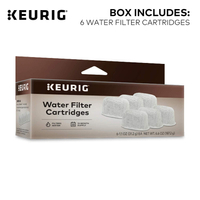Luckily, we’ve compiled a quick guide showing you how to clean a Keurig and make sure every cup is as fresh as the first with a sparkling machine to boot. While this article is geared toward Keurig machines, many of these tips also apply to the best coffee makers and the best espresso machines, and we’re also going into more detail on how to descale a Keurig as well. So you can enjoy your favorite, quality coffee each time.
What can happen if you don’t clean your Keurig coffee maker?
Here are some things that can go wrong if you don’t clean your Keurig regularly:
The needle can get clogged. That means coffee grounds can wind up in your cup, or you might get a “short” cup instead of your regular dose.Your coffee can start to taste bad.Mineral deposits can build up inside the machine, slowing down brewing. Bacteria and mold can grow inside the coffee maker. You may not see it or even taste it, but it’s in there. Yuck!
How to clean a Keurig coffee maker
These steps might seem complicated, but they take only a few minutes. And other than a simple weekly washing, you don’t have to do them often. The payoff is big: great tasting coffee. Be sure to visit the Keurig website, which has short but very helpful videos (opens in new tab) demonstrating each procedure.
What to do every week (or more often if you have the time)
With dishwashing detergent and hot water, wash all of the removable parts of your Keurig, including the water reservoir, the lid, the mug tray and the K-Cup holder. Allow the pieces to air dry; you don’t want dish towel lint in your cup. Take a few minutes to wipe down the surface of the machine.
What to do every two months
Replace the water filter cartridge. After soaking a new cartridge in fresh, cold water for 5 minutes, rinse the cartridge for 60 seconds or so. Then, wash the mesh part of the lower filter holder. Put the cartridge into the upper filter holder, and snap on the lid. Then, lock it into place in the water tank.
What to do every three to six months
Every so often, you’ll need to descale your Keurig coffee maker to remove mineral deposits. Exactly how often depends on how hard your water is. If you notice your machine slowing down, it’s definitely time to descale. Begin the process by filling the reservoir with 10 ounces of plain white vinegar (opens in new tab). Or, you can use Keurig’s descaling solution (opens in new tab). Then, run a couple of brew cycles without a K-Cup, making sure to place a mug underneath to catch the liquid. Finally, run a cycle with 10 ounces of fresh water to rinse out the vinegar.
What to do as often as needed
Whenever you see grounds in your K-Cup holder or your cup or you are shortchanged on coffee, clean the Keurig needles that puncture the K-Cup. To unclog the exit needle, remove and take apart the pod holder, and then use a straightened, unfolded paper clip to clear away any debris. Lift the head, and use the paper clip to clean the holes around the entrance needle. Before reassembling the pod holder, wash it thoroughly. Run two cycles with just water, and then you’re ready to go. If your java tastes like oolong or you make hot cocoa,run a cleansing brew without a K-Cup. Keurig also sells Rinse Pods (opens in new tab) that can help eliminate flavor transfer. It’s a good idea to run a cleansing cycle once a week if you brew a lot of different beverages throughout the week.
